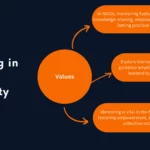
Attracting and retaining good talent is one of the biggest problems faced in the business world. Resignations or silent departures are proof that people no longer want to accept toxic work cultures. Combating this situation can increase employee job satisfaction by creating a community in the workplace, contributing to the overall success of the company. Creating a community can be possible in multiple ways. A coffee roulette can be a good way to create communication within the workplace. Building a community allows individuals to feel part of a whole. The bond established in the workplace through community strengthens collaboration and open communication, creating a more productive and happy work culture. Learning how to bring people together in the workplace is the most important step in this process.
What is a Community in the Workplace?
A community is a social structure where people come together to share the same space, values, experiences, and interests. A workplace community is a structure that creates a bond and sense of belonging among employees at work. This structure is important for the accomplishment of tasks and for people to feel like a whole in the workplace. A workplace community allows employees to share their values, work toward common goals, and support each other.
Building any kind of community in the workplace creates an environment where employees feel connected to their coworkers or the existing organization. It goes beyond superficial friendships and mundane workplace activities; it aims to create a workplace culture where people truly care about their colleagues.
Benefits of Building Community in the Workplace
Building community within a professional workplace is key to organizational success. In workplaces where employees feel like part of a community, important values such as respect, trust, empathy, and collaboration emerge.
Rather than focusing solely on strengthening individual roles, this approach also contributes to increased overall job performance and employee engagement. A work environment focused on building community creates a culture where everyone is willing to do their part to achieve success.
Increases Employee Loyalty
When employees work feeling like they are part of a community, they will feel a strong sense of belonging to their workplace. For example, if an employee works in an environment where they feel valued, they tend to work longer at the company and do not think about changing jobs.
Improves Communication
A community ensures open and effective communication between employees. For example, communication and collaboration between teams ensure that work is completed more efficiently and accurately. In a work environment where communication skills are developed, there are no misunderstandings and conflicts.
Increases Motivation
If individuals in a society feel that their efforts are noticed and appreciated, their motivation increases. For example, celebrating successes or rewarding employees with small incentives allows them to adopt an energetic and passionate approach to their work. Motivated employees are more productive and innovative.
Reduces Stress
Employees in a supportive community can easily cope with stress. For example, when an employee is working on a challenging project, any support or morale from colleagues can help relieve the pressure.
Encourages Creativity
A community where individuals with different experiences come together brings together a variety of perspectives. This supports innovation and problem-solving. For example, innovative thinking can be encouraged by providing an environment where employees can share their ideas freely and receive feedback openly.
10 Ways to Build Community in the Workplace
Create Communication Channels
Creating an environment where ideas can be shared freely is the cornerstone of a sense of community. Regular team meetings can provide a place for discussions on projects and for employees to voice their concerns. You can also use a variety of communication tools, such as anonymous surveys or suggestion boxes, to facilitate feedback processes.
Arrange Team Events
Organizing social events outside of work where employees can freely express themselves can help employees get to know each other better. For example, different activities such as going bowling, taking nature walks, or planning workshops can strengthen the bonds between team members. These events can go beyond the formal work environment and create a friendly atmosphere where people can discover what they have in common.
Set Shared Goals
When employees come together for a cause, it strengthens team spirit. By setting a company-wide goal, everyone can be on board. For example, you can start a project or invite them to lead an innovation effort for a specific customer.
Celebrate Successes
Celebrating successes is the first step to increasing motivation. You can share successes in team meetings or organize an “Employee of the Month” program. In addition, giving small awards or making gestures such as thank-you messages will make employees feel valued.
Start Mentoring Programs
Experienced employees can be encouraged to share knowledge by working with newcomers. Mentoring programs in particular help new employees adapt to the company culture. The bonds established between mentors and mentees create strong communication in the workplace.
Create Social Areas
Create social areas where employees can chat comfortably during breaks and not be supervised. You can create coffee corners, comfortable outdoor seating areas, or break rooms. Such areas allow for warm relationships to be established between employees.
Encourage Diversity Equity and Inclusion
Creating a community in the workplace that accommodates different perspectives creates an environment where individuals feel accepted. You can organize events that highlight the contributions of employees from different cultures, or you can develop diversity awareness by preparing training programs.
Determine Shared Values
Commonly defining the company’s values with employees is a powerful way to build community. For example, you can discuss the mission and vision in team meetings and observe how employees can contribute to these values.
Participate in Volunteer Projects
Participating in social responsibility projects as a team and company strengthens the sense of community. For example, supporting a local organization, cleaning the environment, or participating in school projects creates a strong social bond between employees.
Use Digital Tools
You can use digital tools to strengthen the connection between team members who work remotely and team members who work in a physical workplace. For example, popular platforms such as Slack and Microsoft Teams make it easy for employees to stay in constant communication.


